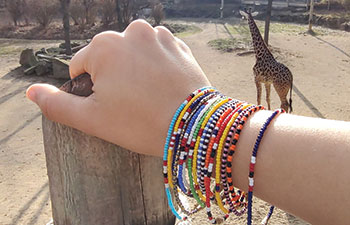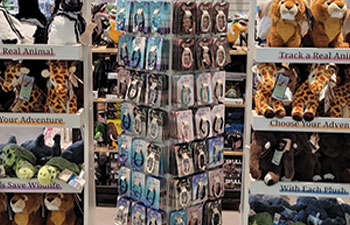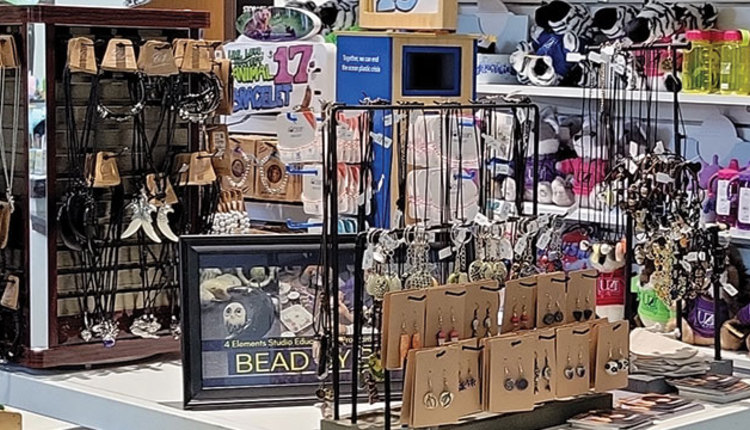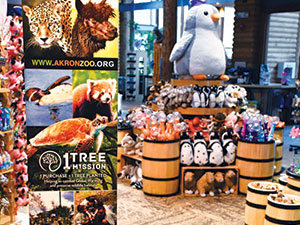Zoo gift shops are finding success with trending jewelry styles, animal themes and conservation brands that appeal to a diverse crowd. A destination retailer’s bestselling products usually represent themes featured at their respective attraction. For zoo shops, merchandise tends to be driven by popular animal exhibits. People want souvenirs that feature animals they saw on their visit.
It’s only fitting then, that when zoo retailers stock their jewelry sections, they make sure popular animals at their zoo are featured on some of their jewelry options.
“Thematically, bestsellers tend to mimic the exhibits at that particular attraction,” explains Paul Meyer, vice president of sales and marketing at Cool Jewels by Phillips.
Some big draws at Ohio’s Akron Zoo include the Humboldt penguins, snow leopards and red pandas. Gift Shop Manager Shannon Sheck notes that the shop’s jewelry featuring these animals tends to do best.
“Any of the jewelry we carry that have our most popular animals on it always sell very well,” she says.
Earlier this year, a baby elephant was born at the Reid Park Zoo in Tucson, Arizona. For that reason, Store Director Kimberley Rohr notes that anything “elephant” seems to sell well for the zoo’s gift shop.
She says, “Everyone loves the elephants here.”
Watching for trendsTimeless bestselling jewelry might always tie to the most popular animal exhibits for zoo shops, but Meyer notes that these destination retailers shouldn’t ignore trends in pop culture to consider for their jewelry.
 Cincinnati Zoo offers handcrafted jewelry from SORALO that supports communities and wildlife in Kenya.
And sometimes the animal themes in jewelry don’t necessarily tie to an animal from the zoo. Shark tooth necklaces and bracelets, for instance, tend to perform well at zoos even if the zoo doesn’t have a shark exhibit, Meyer notes.
At the Woodland Park Zoo in Seattle, however, the zoo’s shops focus on offering jewelry featuring the resident animals, according to Sara Nguyen, store director.
“We don’t want guests to get a sloth necklace when we don’t have a sloth,” she says.
That is of course unless sloths are trending. She explains the zoo’s retail team follows trends and is open to stocking some jewelry outside of the animals living on-site. “If sloth is on trend, we allocate some styles here and there to follow those trends.”
Nguyen adds that it’s not too difficult to find out what animals or themes are “trending,” either. She suggests retailers simply check social media for those kinds of ideas and to see if trends are shifting. As of late, she says capybaras are growing in popularity as a trending animal.
Kyla Jacobs, director of administrative operations at the Utica Zoo in Utica, New York, shares that the zoo’s bestselling jewelry certainly features animals seen at the zoo. But that doesn’t stop her from also carrying jewelry featuring other popular animal themes that guests might love.
“We don’t have an aquarium, but I still do purchase items that are aquatic,” she explains. “I love elephants and giraffes, but we don’t have them on-site.”
Jacobs notes that she gets some ideas for trending products from the Zoo, Aquarium & Garden Buyers Group (ZAG).
“I’m part of ZAG, and we often talk about what works well for our gift shops,” she says. “We also like to work together to find new wholesale businesses that are in line with our typical mission while also providing a great product for our visitors.”
Sheck adds that it’s important to keep a pulse on ever-changing trends and preferences for the zoo shop’s jewelry selection.
“I regularly research trends, upcoming and past, that coincide with our mission,” Sheck says. “I consistently ask myself, ‘How can I improve the quality of the shoppers’ time here by showing what we truly care about?’”
Sustainable sellersSince conservation efforts are key parts of the mission for many zoos, conservation-focused jewelry is often a hit for zoo retailers.
 Utica Zoo offers Fahlo bracelets and plush (top) as well as other brands like 4Ocean (bottom), Live Love Protect and more.
Cool Jewels introduced its first conservation line, 1 Tree Mission, in 2019. Since then, the wholesaler also added two other conservation- specific jewelry lines: the Live Love Protect and Clear Seas Project lines.
In the last year, Fahlo has also been growing in popularity as a conservation-focused jewelry line at many zoo shops. According to Fahlo’s website, the vendor partners with nonprofit organizations to create bracelets that come with a real animal to track.
“By combining a tangible bracelet and interactive tracking experience, our goal is to educate customers about wildlife and excite them about conservation,” Fahlo’s website states.
Rohr says Reid Park Zoo’s gift shop began offering Fahlo bracelets last year. “We offer Fahlo bracelets, including the elephant and lion ones,” she says. “Those are extremely popular among guests, and it exploded on Instagram and Facebook.”
Reid Park Zoo carries 1 Tree Mission bracelets as well. Rohr says the store even has a TV display that plays advertisements on the Fahlo and 1 Tree Mission bracelets as customers shop.
“The TV display helps speak to the guests in a way that we’re not always able to, giving a backstory to these products,” she says.
Stephanie Seibert, director of retail for SSA Group at the Cincinnati Zoo and Botanical Garden, shares that customers enjoy SORALO bracelets at their shops and appreciate the cause behind them.
SORALO, which stands for “South Rift Association of Land Owners,” is in the South Rift region of Kenya. According to the Cincinnati Zoo, Massai women in these communities craft beadwork as a celebration of their culture. Proceeds from the bracelets go back to the community and wildlife in the area.
“The women of SORALO hand-make the jewelry,” Seibert says. “The proceeds from these sales are reinvested back into the community to help with educational support, public health programs and wildlife coexistence work.”
Jacobs adds that when customers can purchase a product such as a Fahlo or Live Love Protect bracelet that helps animals in the wild, it adds meaning to their purchase.
“It brings it full circle of having them feel connected with their dollar,” says Jacobs. “A lot of people nowadays really do feel what they purchase says something. This helps them feel what they’re purchasing is going in the right area.”
From kids to adultsJewelry is a popular seller regardless of age, so zoo retailers often stock something for every age group to enjoy. Since many schools make field trips to zoos, it’s important to have a good selection of jewelry available to children, tweens and teens.
Nguyen says she’s always surprised at the timeless popularity of mood jewelry among kids.
“Mood jewelry is still a thing — it’s never gone away!” she says. “Kids are still interested in it, it changes colors. I don’t think that product is going away.”
Jacobs says the Utica Zoo has a lot of options $15 and under in the jewelry department for kids, such as friendship necklaces, mood rings and more. She says she also stocks some local jewelry that is handmade by kids in the area.
Nguyen jokes that she sometimes sees adults interested in the kids’ jewelry offerings. But generally, she adds, adults appreciate jewelry with conservation or purpose behind it.
Woodland Park Zoo’s retail currently carries some high-end, hand-beaded jewelry from a local artist that Nguyen says might appeal to some adult customers who live in the area.
“While we’re a tourist location, we also keep in mind that nine months out of the year, we have mostly local guests who are members,” says Nguyen, adding that it’s important to offer something for everyone who comes to the zoo.
Meyer agrees with that sentiment and concludes that zoo retailers need to be aware of the demographics visiting their location.
“Regardless of the type of industry you’re in, it’s important to make sure you have merchandise selection that appeals to different audiences you attract,” he says. “It’s understanding your audience and developing the merchandise mix that appeals to each of those segments.”
|




